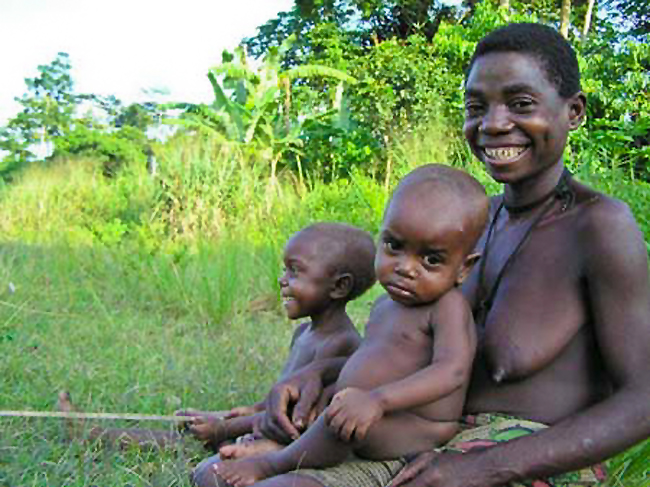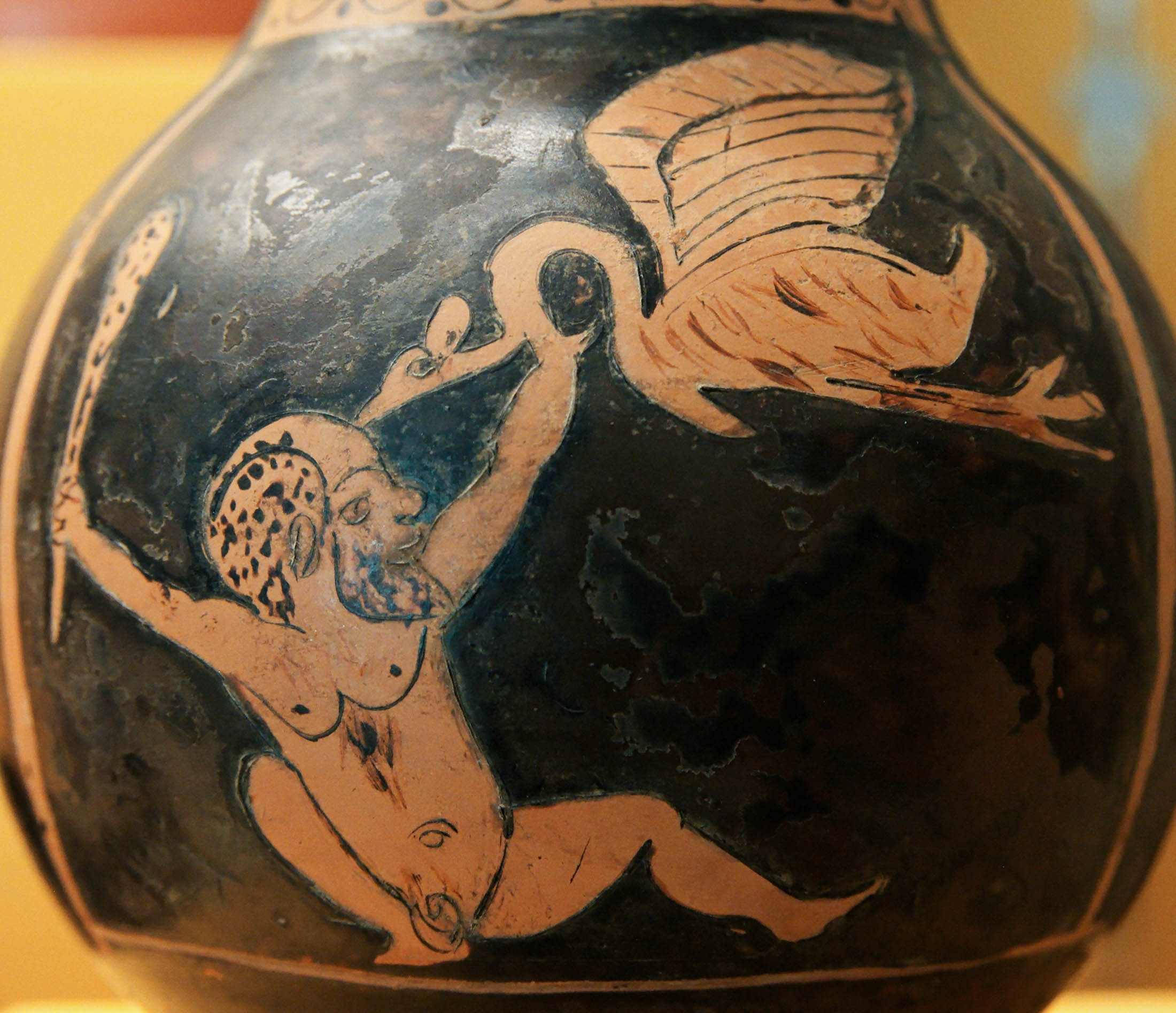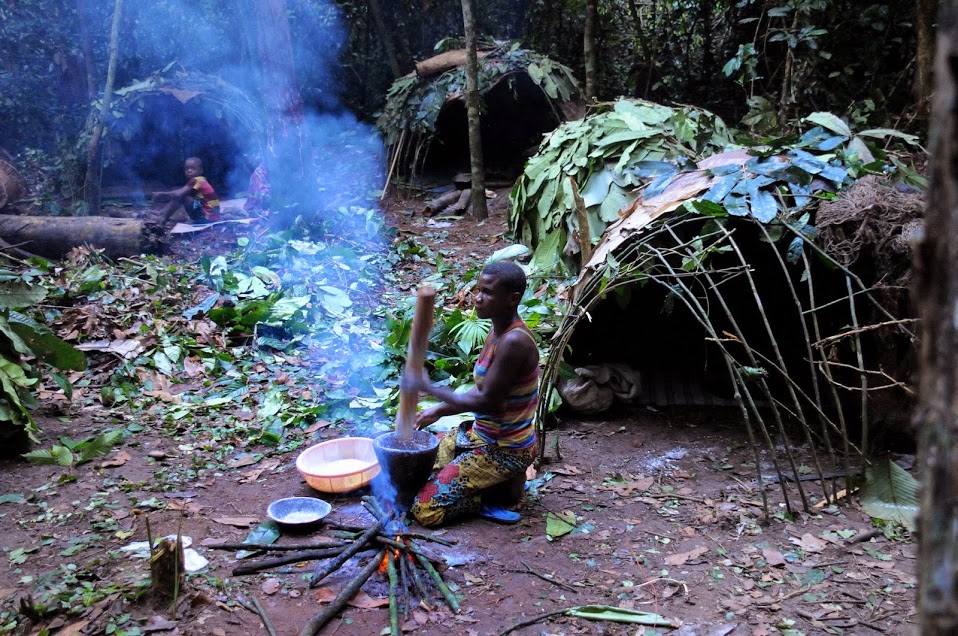|
Pygmies
In anthropology, pygmy peoples are ethnic groups whose average height is unusually short. The term pygmyism is used to describe the phenotype of endemic short stature (as opposed to disproportionate dwarfism occurring in isolated cases in a population) for populations in which adult men are on average less than tall. Although the term is sometimes considered derogatory because it focuses on a physical trait, it remains the primary term associated with the African Pygmies, the hunter-gatherers of the Congo Basin (comprising the Bambenga, Bambuti and Batwa). The terms "Asiatic pygmies" and "Oceanic pygmies" have also been used to describe the Negrito populations of Southeast Asia and Australo-Melanesian peoples of short stature. The Taron people of Myanmar are an exceptional case of a pygmy population of East Asian phenotype. Etymology The term ''pygmy'', as used to refer to diminutive people, comes via Latin from Greek πυγμαῖος ''pygmaîos'', derived from � ... [...More Info...] [...Related Items...] OR: [Wikipedia] [Google] [Baidu] |
African Pygmies
The African Pygmies (or Congo Pygmies, variously also Central African foragers, African rainforest hunter-gatherers (RHG) or Forest People of Central Africa) are a group of ethnicities Indigenous peoples of Africa, native to Central Africa, mostly the Congo Basin, traditionally subsisting on a foraging, forager and hunter-gatherer lifestyle. They are divided into three roughly geographic groups: *The western ''Bambenga'', or ''Mbenga'' (Cameroon, Gabon, Republic of the Congo, Central African Republic), *the eastern ''Bambuti'', or ''Mbuti'', of the Congo basin (Democratic Republic of the Congo, DRC) *the central and southern ''Batwa'', or ''Twa'' (Rwanda, Burundi, Democratic Republic of the Congo, DRC, Tanzania, Uganda, Zambia, Angola and Namibia). The more widely scattered (and more variable in physiology and lifestyle) Southern Twa are also grouped under the term Pygmoid. They are notable for, and named for, their short stature (described as "pygmyism" in anthropological l ... [...More Info...] [...Related Items...] OR: [Wikipedia] [Google] [Baidu] |
Bambenga
The African Pygmies (or Congo Pygmies, variously also Central African foragers, African rainforest hunter-gatherers (RHG) or Forest People of Central Africa) are a group of ethnicities native to Central Africa, mostly the Congo Basin, traditionally subsisting on a forager and hunter-gatherer lifestyle. They are divided into three roughly geographic groups: *The western ''Bambenga'', or ''Mbenga'' (Cameroon, Gabon, Republic of the Congo, Central African Republic), *the eastern '' Bambuti'', or ''Mbuti'', of the Congo basin (DRC) *the central and southern '' Batwa'', or ''Twa'' (Rwanda, Burundi, DRC, Tanzania, Uganda, Zambia, Angola and Namibia). The more widely scattered (and more variable in physiology and lifestyle) Southern Twa are also grouped under the term Pygmoid. They are notable for, and named for, their short stature (described as " pygmyism" in anthropological literature). They are assumed to be descended from the original Middle Stone Age expansion of anato ... [...More Info...] [...Related Items...] OR: [Wikipedia] [Google] [Baidu] |
Pygmy (Greek Mythology)
The Pygmies ( ''Pygmaioi'', from the adjective πυγμαῖος, from the noun πυγμή ''pygmē'' "fist, boxing, distance from elbow to knuckles," from the adverb πύξ ''pyx'' "with the fist") were a tribe of diminutive humans in Greek mythology. Attestations According to the ''Iliad'', they were involved in a constant war with the Crane (bird), cranes, which migrated in winter to their homeland on the southern shores of the earth-encircling river Oceanus: According to Aristotle in ''History of Animals'', the story is true: Hesiod wrote that Epaphus, son of Zeus, through his daughters was the ancestor of the "dark Libyans, and high-souled Aethiopians, and the Underground-folk and feeble Pygmies". According to Stephanus of Byzantium, the tribe of Pygmies was descended from Pygmaeus, Pygmaios, son of Dorus (mythology), Doros, son of Epaphus. One story in Ovid describes the origin of the age-old battle, speaking of a Pygmy Queen named Gerana who offended the goddess Her ... [...More Info...] [...Related Items...] OR: [Wikipedia] [Google] [Baidu] |
Aka People
The Aka or Biaka (also ''Bayaka, ''Babenzele) are a nomadic African Pygmies, Mbenga pygmy people. They live in south-western Central African Republic and in northern Republic of the Congo. They are related to the Baka (Cameroon and Gabon), Baka people of Cameroon, Gabon, northern Congo, and southwestern Central African Republic. Unlike the Mbuti pygmies of the eastern Congo (who speak only the language of the tribes with whom they are affiliated), the Aka speak Aka language, their own language along with whichever of the approximately 15 Bantu peoples they are affiliated. In 2003, the oral traditions of the Aka were proclaimed one of the Masterpieces of the Oral and Intangible Heritage of Humanity by UNESCO. They were featured in the July 1995 National Geographic Magazine, National Geographic article "Ndoki: the Last Place on Earth", and a 3-part TV series. Society A traditional hunter-gatherer society, the Aka have a varied diet that includes 63 plants, 28 species of game ... [...More Info...] [...Related Items...] OR: [Wikipedia] [Google] [Baidu] |
Bambuti
The Mbuti people, or Bambuti, are one of several indigenous pygmy groups in the Congo region of Africa. Their languages are Central Sudanic languages and Bantu languages. Subgroups Bambuti are pygmy hunter-gatherers, and are one of the oldest indigenous people of the Congo region of Africa. The Bambuti are composed of bands which are relatively small in size, ranging from 15 to 60 people. The Bambuti population totals about 30,000 to 40,000 people. Many Batwa in various parts of the Democratic Republic of the Congo (DRC) also call themselves Bambuti. There are three distinct subgroups: * The Sua (also Kango, or Mbuti), who speak a dialect (or perhaps two) of the language of a neighboring Bantu people, Bila. They are located centrally and are eponymous of the larger group. * The Efé, who speak the language of the neighboring Central Sudanic Lese. * The Asua, speakers of the Mangbetu (Central Sudanic) Asua language. Environment The Mbuti population live in the Itu ... [...More Info...] [...Related Items...] OR: [Wikipedia] [Google] [Baidu] |
Batwa
The Twa, often referred to as Batwa or Mutwa (singular), are indigenous hunter-gatherer peoples of the Great Lakes Region in Central Africa, recognized as some of the earliest inhabitants of the area. Historically and academically, the term “Pygmy” has been used to describe these groups, however, it is considered derogatory, particularly by the Twa themselves. While some Batwa activists accept the term as an acknowledgement of their indigenous status, most prefer specific ethnic labels such as Bambuti (for the Ituri Forest region in the Democratic Republic of the Congo), Baaka (Lobaye Forest, Central African Republic), and Bambendjelle (Ndoki Forest, Congo-Brazzaville and Central African Republic). Relation to the Bantu populations All Twa populations live near or in agricultural villages. Agricultural Bantu peoples have settled a number of ecotones next to an area that has game but will not support agriculture, such as the edges of the rainforest, open swamp, and desert. ... [...More Info...] [...Related Items...] OR: [Wikipedia] [Google] [Baidu] |
Congo Basin
The Congo Basin () is the sedimentary basin of the Congo River. The Congo Basin is located in Central Africa, in a region known as west equatorial Africa. The Congo Basin region is sometimes known simply as the Congo. It contains some of the largest tropical rainforests in the world and is an important source of water used in agriculture and energy generation. The rainforest in the Congo Basin is the largest rainforest in Africa and second only to the Amazon rainforest in size, with 300 million hectares compared to the 800 million hectares in the Amazon. Because of its size and diversity the basin's forest is important for mitigating climate change in its role as a carbon sink. However, deforestation and degradation of the ecology by the impacts of climate change may increase stress on the forest ecosystem, in turn making the hydrology of the basin more variable. A 2012 study found that the variability in precipitation caused by climate change will negatively affect economic a ... [...More Info...] [...Related Items...] OR: [Wikipedia] [Google] [Baidu] |
Taron People
The Taron or T’rung ( ) are an ethnic group in the Himalayan foothills of northern Kachin State, Myanmar, whose population is declining to the point where they may disappear entirely. They have been referred to as the "East Asian pygmies". They are allegedly descended from an ethnic group concentrated in China known as Derung who migrated to Burma from Tibet in the 1880s. Like the Pygmies of Central Africa and the Negritos of Southeast Asia, the Tarons are very small, with an average height of for males, and for females. History The Tarons have received their name from their original homeland, the headwaters of the Taron River (Derong/Dulong). Leaving their original homeland around 200 years ago, the Tarons moved into Burma territory through the Thalalarkha mountain pass. They settled in Kachin State, in the lower Adunlaung River valley in the Naung Mun Township of Putao District. The landscape is dense forests and difficult terrain, with torrential streams and snow-clad m ... [...More Info...] [...Related Items...] OR: [Wikipedia] [Google] [Baidu] |
Central Africa
Central Africa (French language, French: ''Afrique centrale''; Spanish language, Spanish: ''África central''; Portuguese language, Portuguese: ''África Central'') is a subregion of the African continent comprising various countries according to different definitions. Middle Africa is an analogous term used by the United Nations in its United Nations geoscheme for Africa, geoscheme for Africa and consists of the following countries: Angola, Cameroon, Central African Republic, Chad, Democratic Republic of the Congo, Republic of the Congo, Equatorial Guinea, Gabon, and São Tomé and Príncipe. The United Nations Office for Central Africa also includes Burundi and Rwanda in the region, which are considered part of East Africa in the geoscheme. These eleven countries are members of the Economic Community of Central African States (ECCAS). Six of those countries (Cameroon, Central African Republic, Chad, Equatorial Guinea, Gabon, and Republic of the Congo) are also members of the ... [...More Info...] [...Related Items...] OR: [Wikipedia] [Google] [Baidu] |
Hunter-gatherer
A hunter-gatherer or forager is a human living in a community, or according to an ancestrally derived Lifestyle, lifestyle, in which most or all food is obtained by foraging, that is, by gathering food from local naturally occurring sources, especially wild edible plants but also insects, Fungus, fungi, Honey hunting, honey, Eggs as food, bird eggs, or anything safe to eat, or by hunting game (pursuing or trapping and killing Wildlife, wild animals, including Fishing, catching fish). This is a common practice among most vertebrates that are omnivores. Hunter-gatherer Society, societies stand in contrast to the more Sedentism, sedentary Agrarian society, agricultural societies, which rely mainly on cultivating crops and raising domesticated animals for food production, although the boundaries between the two ways of living are not completely distinct. Hunting and gathering was humanity's original and most enduring successful Competition (biology), competitive adaptation in the nat ... [...More Info...] [...Related Items...] OR: [Wikipedia] [Google] [Baidu] |
Mongoloid
Mongoloid () is an obsolete racial grouping of various peoples indigenous to large parts of Asia, the Americas, and some regions in Europe and Oceania. The term is derived from a now-disproven theory of biological race. In the past, other terms such as " Mongolian race", "yellow", "Asiatic" and " Oriental" have been used as synonyms. The concept of dividing humankind into the Mongoloid, Caucasoid, and Negroid races was introduced in the 1780s by members of the Göttingen school of history. It was further developed by Western scholars in the context of racist ideologies during the age of colonialism. The organization has since been renamed the American Association of Biological Anthropologists. With the rise of modern genetics, the concept of distinct human races in a biological sense has become obsolete. In 2019, the American Association of Biological Anthropologists stated: "The belief in 'races' as natural aspects of human biology, and the structures of inequality (racism) t ... [...More Info...] [...Related Items...] OR: [Wikipedia] [Google] [Baidu] |
Natural History
Natural history is a domain of inquiry involving organisms, including animals, fungi, and plants, in their natural environment, leaning more towards observational than experimental methods of study. A person who studies natural history is called a naturalist or natural historian. Natural history encompasses scientific research but is not limited to it. It involves the systematic study of any category of natural objects or organisms, so while it dates from studies in the ancient Greco-Roman world and the mediaeval Arabic world, through to European Renaissance naturalists working in near isolation, today's natural history is a cross-discipline umbrella of many specialty sciences; e.g., geobiology has a strong multidisciplinary nature. Definitions Before 1900 The meaning of the English term "natural history" (a calque of the Latin ''historia naturalis'') has narrowed progressively with time, while, by contrast, the meaning of the related term "nature" has widened (see also ... [...More Info...] [...Related Items...] OR: [Wikipedia] [Google] [Baidu] |









